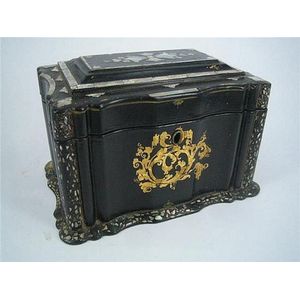Victorian Tea Caddy with Mother of Pearl Inlay
You must be a subscriber, and be logged in to view price and dealer details.
Subscribe Now to view actual auction price for this item
When you subscribe, you have the option of setting the currency in which to display prices to $Au, $US, $NZ or Stg.
- Japanning - Japanning is the early eighteenth century technique used by European craftsmen to imitate the oriental style lacquer work that became popular in England, France, the Netherlands, and Spain in the 17th century.
The lacquer used was based on the lac beetle dissolved in alcohol (as used in French polish) and differed from the Chinese lacquer which was based on tree sap.
Each layer of the lacquer was allowed to dry and then sanded down. It was applied over cream, yellow, green, red, or black grounds. Japanning using gold leaf was also widely used with lacquer work. The technique can be found on bureaux, cabinets, chests, longcase clocks, and chairs. - Mother-Of-Pearl - Mother-of-pearl, technical name "nacre", is the inner layer of a sea shell. The iridescent colours and strength of this material were widely used in the nineteenth century as an inlay in jewellery, furniture, (especially papier mache furniture) and musical instruments.
In the early 1900s it was used to make pearl buttons. Mother-of-pearl is a soft material that is easily cut or engraved.
Nowadays it is a by-product of the oyster, freshwater pearl mussel and abalone industries. - Victorian Period - The Victorian period of furniture and decorative arts design covers the reign of Queen Victoria from 1837 to 1901. There was not one dominant style of furniture in the Victorian period. Designers used and modified many historical styles such as Gothic, Tudor, Elizabethan, English Rococo, Neoclassical and others, although use of some styles, such as English Rococo and Gothic tended to dominate the furniture manufacture of the period.
The Victorian period was preceded by the Regency and William IV periods, and followed by the Edwardian period, named for Edward VII (1841 ? 1910) who was King of the United Kingdom and the British Dominions and Emperor of India for the brief period from 1901 until his death in 1910.
This item has been included into following indexes:
Visually similar items

An important museum quality ships cabin trunk, Australian red cedar and whale bone with rope and leather handles, early 19th century, 56 cm high, 100.5 cm wide, 50 cm deep

A George III flame mahogany inlaid tea caddy, rectangular form, satinwood and ebony strung, shell and floral inlays, a two-compartment interior. Compressed bun feet. 20.3 cm x 13 cm x 13.5 cm

Late 19th century Anglo-Indian teak blanket box the whole elaborately carved with florals, scrolls on bun feet

A George III mahogany tea caddy, early 19th century (2). A George III mahogany tea caddy, early 19th century of sarcophagus form, the domed lid with boxwood stringing and parquetry banding opening to reveal compartments for caddies and a crystal mixing bow
